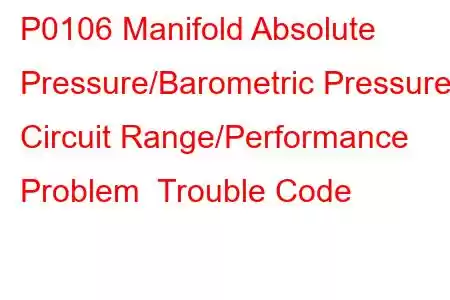P0106 - MAP/Barometric Pressure Circuit Range/Performance Problem
OBD-II Trouble Code Technical Description
Manifold Absolute Pressure/Barometric Pressure Circuit Range/Performance Problem
What does that mean?
This diagnostic trouble code (DTC) is a generic powertrain code, which means that it applies to OBD-II equipped vehicles. Although generic, the specific repair steps may vary depending on make/model.
The Powertrain Control Module (PCM) uses the Manifold Absolute Pressure Sensor (MAP) to monitor engine load. (NOTE: Some vehicles have a Barometric Pressure (BARO) sensor that is integral to the Mass Air Flow (MAF) sensor and do not have a MAP sensor. Other vehicles have a MAF/BARO and a redundant MAP sensor where the MAP sensor functions as a backup input in case of MAF failure.
The PCM supplies a 5 Volt reference signal to the MAP sensor. Usually the PCM also supplies a ground circuit to the MAP sensor as well. As the manifold pressure changes with load, the MAP sensor input informs the PCM. At idle the voltage should be 1 to 1.5 Volts and approximately 4.5 Volts at Wide Open Throttle (WOT). The PCM looks for any change in manifold pressure to be preceded by a change in engine load in the form of changes in throttle angle, engine speed, or Exhaust Gas Recirculation (EGR) flow. If the PCM doesn't see any of these factors change while detecting a rapid change in MAP value, it will set a P0106.
A typical MAP sensor
Potential Symptoms
The following could be symptomatic of a P0106:
Engine runs rough Black smoke at tailpipe Engine will not idle Poor fuel economy Engine misses at speedCauses
A P0106 could be caused by:
Bad MAP sensor Water/dirt intrusion affecting MAP sensor connector Intermittent open in the reference, ground, or signal wire for the MAP sensor Intermittent short in the reference, ground, or signal wire for the MAP sensor Ground problem due to corrosion causing intermittent signal problem A break in the flexible air intake duct between the MAF and the intake manifold Bad PCM (do not assume the PCM is bad until you've exhausted all other possibilities)Possible Solutions
Using a scan tool, watch the MAP sensor value with the key on, engine off. Compare the BARO reading with the MAP reading. They should be roughly equal. The voltage for the MAP sensor should read approx. 4.5 volts. Now start the engine and look for a significant drop in the MAP sensor voltage indicating the MAP sensor is working.
If the MAP reading doesn't change perform the following:
With the Key on, engine off, disconnect the vacuum hose from the MAP sensor. Using a vacuum pump, pull 20 in. of vacuum on the MAP sensor. Does the voltage drop? It should. If it doesn't inspect the MAP sensor vacuum port and vacuum hose to manifold for a restriction of some kind. Repair or replace as necessary. If there are no restrictions, and the value doesn't change with vacuum, then perform the following: with the Key on and engine off and the MAP sensor unplugged, check for 5 Volts at the reference wire to the MAP sensor connector with a Digital Voltmeter. If there is none, check for reference voltage at the PCM connector. If the reference voltage is present at the PCM connector but not the MAP connector, check for open or short in the reference wire between MAP and PCM and retest. If reference voltage is present, then check for existing ground at the MAP sensor connector. If it isn't present then repair open/short in the ground circuit. If ground is present, then replace MAP sensor.Other MAP sensor trouble codes include P0105, P0107, P0108 and P0109.
Read: 51


